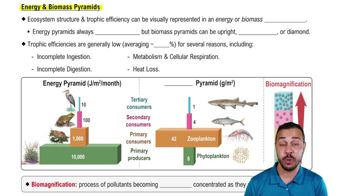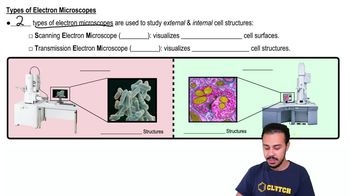Table of contents
- 1. Introduction to Biology2h 42m
- 2. Chemistry3h 40m
- 3. Water1h 26m
- 4. Biomolecules2h 23m
- 5. Cell Components2h 26m
- 6. The Membrane2h 31m
- 7. Energy and Metabolism2h 0m
- 8. Respiration2h 40m
- 9. Photosynthesis2h 49m
- 10. Cell Signaling59m
- 11. Cell Division2h 47m
- 12. Meiosis2h 0m
- 13. Mendelian Genetics4h 44m
- Introduction to Mendel's Experiments7m
- Genotype vs. Phenotype17m
- Punnett Squares13m
- Mendel's Experiments26m
- Mendel's Laws18m
- Monohybrid Crosses19m
- Test Crosses14m
- Dihybrid Crosses20m
- Punnett Square Probability26m
- Incomplete Dominance vs. Codominance20m
- Epistasis7m
- Non-Mendelian Genetics12m
- Pedigrees6m
- Autosomal Inheritance21m
- Sex-Linked Inheritance43m
- X-Inactivation9m
- 14. DNA Synthesis2h 27m
- 15. Gene Expression3h 20m
- 16. Regulation of Expression3h 31m
- Introduction to Regulation of Gene Expression13m
- Prokaryotic Gene Regulation via Operons27m
- The Lac Operon21m
- Glucose's Impact on Lac Operon25m
- The Trp Operon20m
- Review of the Lac Operon & Trp Operon11m
- Introduction to Eukaryotic Gene Regulation9m
- Eukaryotic Chromatin Modifications16m
- Eukaryotic Transcriptional Control22m
- Eukaryotic Post-Transcriptional Regulation28m
- Eukaryotic Post-Translational Regulation13m
- 17. Viruses37m
- 18. Biotechnology2h 58m
- 19. Genomics17m
- 20. Development1h 5m
- 21. Evolution3h 1m
- 22. Evolution of Populations3h 52m
- 23. Speciation1h 37m
- 24. History of Life on Earth2h 6m
- 25. Phylogeny2h 31m
- 26. Prokaryotes4h 59m
- 27. Protists1h 12m
- 28. Plants1h 22m
- 29. Fungi36m
- 30. Overview of Animals34m
- 31. Invertebrates1h 2m
- 32. Vertebrates50m
- 33. Plant Anatomy1h 3m
- 34. Vascular Plant Transport1h 2m
- 35. Soil37m
- 36. Plant Reproduction47m
- 37. Plant Sensation and Response1h 9m
- 38. Animal Form and Function1h 19m
- 39. Digestive System1h 10m
- 40. Circulatory System1h 57m
- 41. Immune System1h 12m
- 42. Osmoregulation and Excretion50m
- 43. Endocrine System1h 4m
- 44. Animal Reproduction1h 2m
- 45. Nervous System1h 55m
- 46. Sensory Systems46m
- 47. Muscle Systems23m
- 48. Ecology3h 11m
- Introduction to Ecology20m
- Biogeography14m
- Earth's Climate Patterns50m
- Introduction to Terrestrial Biomes10m
- Terrestrial Biomes: Near Equator13m
- Terrestrial Biomes: Temperate Regions10m
- Terrestrial Biomes: Northern Regions15m
- Introduction to Aquatic Biomes27m
- Freshwater Aquatic Biomes14m
- Marine Aquatic Biomes13m
- 49. Animal Behavior28m
- 50. Population Ecology3h 41m
- Introduction to Population Ecology28m
- Population Sampling Methods23m
- Life History12m
- Population Demography17m
- Factors Limiting Population Growth14m
- Introduction to Population Growth Models22m
- Linear Population Growth6m
- Exponential Population Growth29m
- Logistic Population Growth32m
- r/K Selection10m
- The Human Population22m
- 51. Community Ecology2h 46m
- Introduction to Community Ecology2m
- Introduction to Community Interactions9m
- Community Interactions: Competition (-/-)38m
- Community Interactions: Exploitation (+/-)23m
- Community Interactions: Mutualism (+/+) & Commensalism (+/0)9m
- Community Structure35m
- Community Dynamics26m
- Geographic Impact on Communities21m
- 52. Ecosystems2h 36m
- 53. Conservation Biology24m
5. Cell Components
Microscopes
Problem 2`
Textbook Question
The ultrastructure of a chloroplast is best studied using a a. light microscope. b. scanning electron microscope. c. transmission electron microscope. d. light microscope and fluorescent dyes.
 Verified step by step guidance
Verified step by step guidance1
Understand the question: The problem asks which type of microscope is best suited to study the ultrastructure of a chloroplast. The term 'ultrastructure' refers to the fine details of a cell's internal structure, typically at the molecular or organelle level.
Review the options: Each type of microscope has specific capabilities. A light microscope is limited in resolution and cannot reveal ultrastructural details. A scanning electron microscope (SEM) provides detailed surface images but not internal structures. A transmission electron microscope (TEM) is designed to study internal structures at high resolution. Light microscopes with fluorescent dyes enhance visualization but still lack the resolution needed for ultrastructure.
Recall the principle of resolution: The resolution of a microscope determines its ability to distinguish between two closely spaced points. TEMs have the highest resolution among the options listed, allowing them to visualize ultrastructural details such as thylakoid membranes and grana within chloroplasts.
Match the tool to the task: Since the question specifies studying the ultrastructure, the microscope must provide high-resolution images of internal structures. This aligns with the capabilities of a transmission electron microscope (TEM).
Conclude the reasoning: Based on the above analysis, the transmission electron microscope (TEM) is the most appropriate tool for studying the ultrastructure of a chloroplast.
 Verified video answer for a similar problem:
Verified video answer for a similar problem:This video solution was recommended by our tutors as helpful for the problem above
Video duration:
1mPlay a video:
Was this helpful?
Key Concepts
Here are the essential concepts you must grasp in order to answer the question correctly.
Chloroplast Structure
Chloroplasts are organelles found in plant cells and some algae, responsible for photosynthesis. They contain thylakoids, which are membrane-bound structures where light-dependent reactions occur, and stroma, the fluid surrounding thylakoids where the Calvin cycle takes place. Understanding their ultrastructure is crucial for studying how plants convert light energy into chemical energy.
Recommended video:
Guided course

Chloroplast Structure
Microscopy Techniques
Different microscopy techniques provide varying levels of detail and types of information about cellular structures. Light microscopes allow for the observation of living cells but have limited resolution. In contrast, electron microscopes, such as scanning and transmission types, offer much higher resolution, enabling the visualization of ultrastructural details at the nanometer scale, which is essential for studying chloroplasts.
Recommended video:
Guided course

Microscopes
Resolution and Magnification
Resolution refers to the ability of a microscope to distinguish between two closely spaced objects, while magnification is the process of enlarging an image. For studying chloroplast ultrastructure, high resolution is necessary to observe fine details such as thylakoid membranes and granum stacks. Transmission electron microscopes provide the highest resolution, making them ideal for examining the intricate structures within chloroplasts.
Recommended video:
Guided course

Energy & Biomass Pyramids
Related Videos
Related Practice










